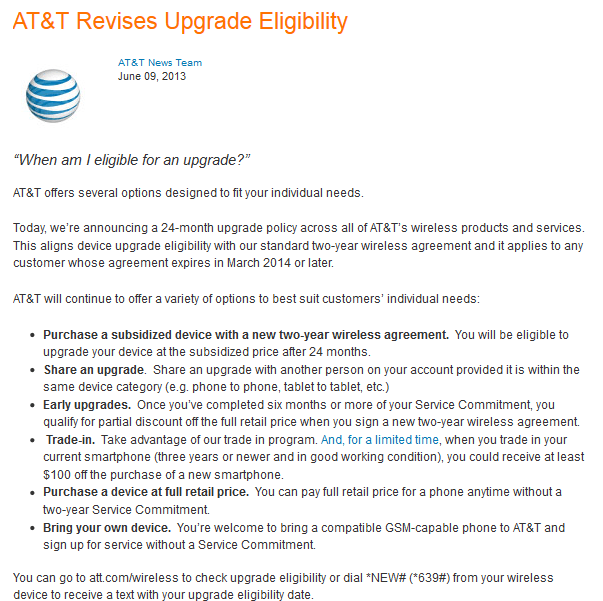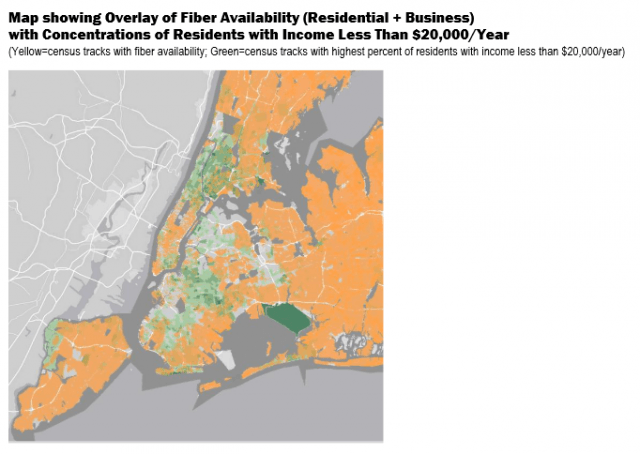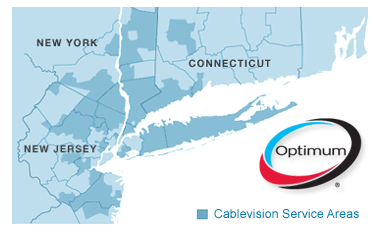 AT&T has once again followed Verizon Wireless’ lead by ending early upgrades for contract customers, making it impossible to upgrade a handset with a full device subsidy until 24 months have passed.
AT&T has once again followed Verizon Wireless’ lead by ending early upgrades for contract customers, making it impossible to upgrade a handset with a full device subsidy until 24 months have passed.
The changes took effect last Sunday. Customers that bought their current device after March 1, 2012 must now wait four more months before they can get a discounted upgrade. AT&T also will only allow upgrades within the same “device category,” meaning a customer with an expiring smartphone contract cannot use their upgrade discount on a tablet device.
Previously, both Verizon and AT&T offered customers loyalty discounts and early upgrades for customers not minding a two-year contract extension. Device subsidies — discounts extended to customers to cut prices on new smartphones or tablets, are anathema to many Wall Street analysts because they can drag down provider earnings. Cell companies quietly win back the subsidy discount within two years by charging artificially higher rates on service plans. But Wall Street does not like waiting for a two-year payback.
Verizon Wireless and AT&T both charge nearly the same rates and have almost identical policies and discounts. When one carrier raises prices, the other quickly follows. In the past three years, both companies have ended a number of discounts and plan features — notably loyalty upgrade credits and flat rate data plans — in moves to cut costs and increase profitability.
Both Verizon and AT&T have spoken positively about the idea of doing away with phone upgrade subsidies altogether, but neither would say current rates would be lowered in tandem with such a move. Wall Street wants carriers to consider maintaining current pricing and ending phone subsidies, which would dramatically stimulate company earnings. A device subsidy on a top of the line smartphone is worth $150 a year — money that would come from the customer’s pocket, not AT&T or Verizon.
Customers who don’t want to pay AT&T’s contract prices will not find a better deal from its prepaid division. AT&T has also announced it is discontinuing several affordable data plan options effective June 20.
The most-affected plan is AT&T GoPhone’s $25 monthly plan, which includes unlimited texting and 250 minutes of calling. That plan allowed customers to choose between three data packages:
- 50MB for $5/month;
- 200MB for $15/month;
- 1GB for $25/month.
Effective June 20, the only available data add-on for this plan will be the 50MB option. Customers exceeding this will have to re-subscribe for an extra $5 for each renewal.
AT&T’s $50 monthly plan includes unlimited texting and calling. But customers will no longer be able to add data service. Instead, they will have to upgrade to AT&T’s premiere $65 plan, which includes the same features as the $50 plan but adds up to 1GB of data.
AT&T says it will have new options for consumers in the coming weeks, but until then, data customers will often pay an average of at least $15 more per month as the changes take effect.


 Subscribe
Subscribe
 Still waiting for Verizon FiOS in New York City? Are you annoyed that your neighbors have impressive broadband speeds from an all-fiber network while you suffer with DSL or cable broadband from Time Warner or Cablevision? Your landlord may be the problem.
Still waiting for Verizon FiOS in New York City? Are you annoyed that your neighbors have impressive broadband speeds from an all-fiber network while you suffer with DSL or cable broadband from Time Warner or Cablevision? Your landlord may be the problem. In April, Verizon was criticized by New York City public advocate Bill de Blasio for falling behind schedule providing access to FiOS in low-income communities.
In April, Verizon was criticized by New York City public advocate Bill de Blasio for falling behind schedule providing access to FiOS in low-income communities.


 Time Warner Cable has laid the foundation to eventually begin charging broadband customers usage-based pricing, raise the modem rental fee originally introduced last fall, and continue to offer customers unlimited broadband service if they are prepared to pay a new, higher price.
Time Warner Cable has laid the foundation to eventually begin charging broadband customers usage-based pricing, raise the modem rental fee originally introduced last fall, and continue to offer customers unlimited broadband service if they are prepared to pay a new, higher price.

 Cablevision will maintain unlimited Optimum Online broadband service to all of its customers and will not introduce usage-based pricing, according to Gregg Seibert, chief financial officer.
Cablevision will maintain unlimited Optimum Online broadband service to all of its customers and will not introduce usage-based pricing, according to Gregg Seibert, chief financial officer.